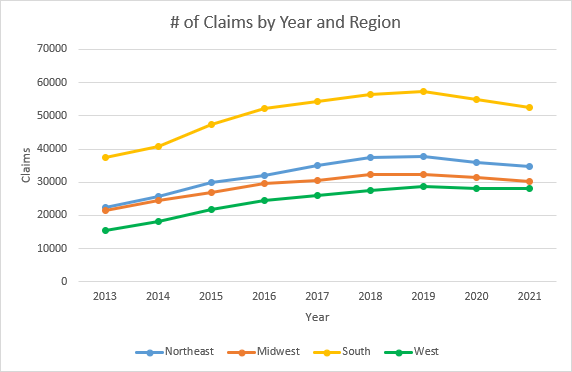BACKGROUND: Potassium citrate is a cornerstone of medical therapy for kidney stone prevention, especially in patients with recurrent calcium oxalate nephrolithiasis. Despite this, barriers exist to widespread use including urologist comfort with prescribing, cost, need for titration and lab follow-up. As the prevalence of kidney stone disease is increasing in the United States, we sought to evaluate geographic prescribing trends of potassium citrate amongst urologists. METHODS: A retrospective analysis of the Centers for Medicare and Medicaid Services (CMS) Part D Prescribers by Provider and Drug database from 2013 - 2021 was conducted. Total number of urologists, the location of prescriber, and number of total claims for potassium citrate were abstracted. Data was grouped into regions as defined by the U.S. Census Bureau. A two-way ANOVA was performed to determine differences across both regions and years. RESULTS: Total Medicare claims for potassium citrate prescriptions increased in all regions from 2013 - 2019, however there was a decrease in prescriptions in all regions from 2019 - 2021. Similarly, the percentage of urologists in the United States prescribing potassium citrate increased from 2013-2019 but decreased from 2019-2021. Overall, the proportion of urologists prescribing potassium citrate increased from 31.0% in 2013 to 41.1% in 2021. The mean number of potassium citrate prescriptions per urologist increased from 10 in 2013 to 15 in 2021. Two-way ANOVA revealed a significant difference in the proportion of urologists prescribing potassium citrate over the time period studied (P < 0.001). Each region reached its highest total number of claims and highest proportion of urologists prescribing potassium citrate in the year 2019 followed by a small decline (Figure 1). CONCLUSIONS:
From 2013-2021, the proportion of urologists prescribing potassium citrate increased overall by approximately 10.1% with the mean number of prescriptions per urologist increasing from 10-15. This is in contrast to a previously reported estimated 2% increase in the incidence of stone disease in the United States over a similar time period (2011-2019) within the Medicare population. There was a statistically significant difference in the proportion of urologists prescribing potassium citrate when comparing regions of the United States over the studied time period. This appears to correlate with previously studied differences in the incidence of kidney stones with the highest prevalence in the Southern region and the lowest prevalence in the West. Drug cost, provider comfort with the medication management or heightened awareness of the benefits for stone disease may be driving increased prescriptions compared to the incidence of stone disease in the US, and the COVID-19 pandemic may be associated with the decline seen after 2019. Further study of regional variation and potential causes of these trends with mixed methods analysis is planned.
Figure 1: Total number of CMS claims for potassium citrate over time
